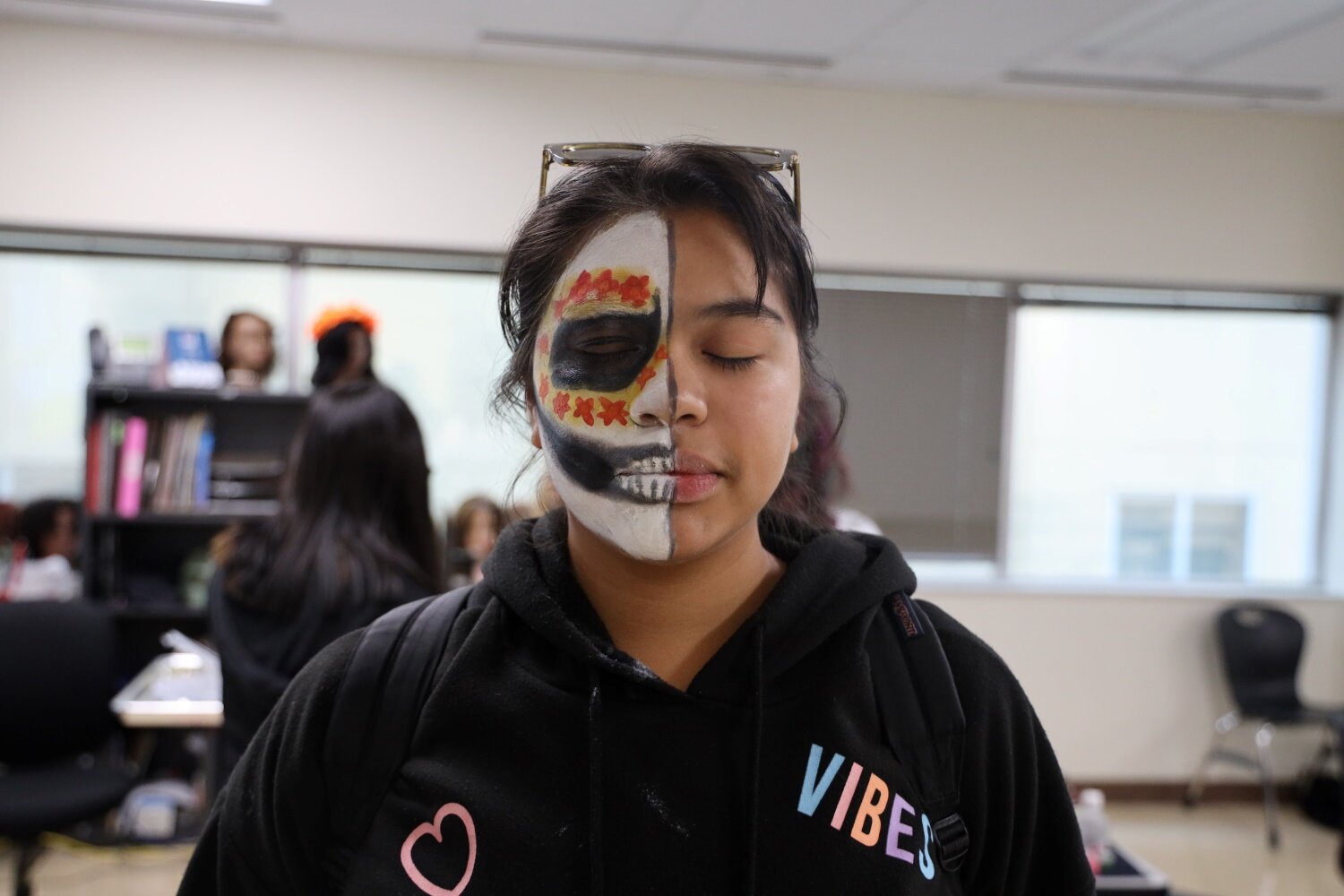Día de los Muertos makeup is anything but skin-deep

DENVER — The sound of laughter and Latin pop music spilled out into the hallway as about a dozen cosmetology students gathered in Lisa Cruz’s classroom at Emily Griffith Technical College. The students sat around tables covered with vibrant eyeshadow palettes and makeup brushes.
At the front of the room, a cosmetology program alumna gave a demonstration for the students, transforming her model’s face into a colorful, intricate skull.
Donning this skull makeup, also known as sugar skull or calavera makeup, is a tradition among those who celebrate Día de los Muertos, or Day of the Dead.
As part of a collaboration with Viva Colorado and Latin Fashion Week, several of Cruz’s students volunteered to apply the calavera makeup on guests at a Día de los Muertos parade and festival happening Saturday, Nov. 4 in Denver.
This is Cruz’s seventh year teaching cosmetology at Emily Griffith Technical College. As an instructor, one of her goals is to expose her students to hands-on experiences within the community.
This event offers an opportunity for Cruz to teach her students technical and professional skills while participating in a holiday special to her.
Día de los Muertos is traditionally celebrated Nov. 1- 2. For some, including Cruz, the celebration begins Oct. 31. Though it falls around the same time as Halloween, Día de los Muertos is a completely different holiday. Over those three days, people welcome the spirits of their loved ones who have passed, honoring their memories and celebrating their lives.
The skull makeup is not a costume, and it’s not designed to be scary. Its message is about accepting death, not fearing it.
"The fact that we're embracing that look of death just makes everyone around us, including kids, family members, feel a little more comfortable around it instead of having to hide from it,” cosmetology student and volunteer Fernanda Salas said.
Salas was born and raised in Mexico and celebrates Día de los Muertos every year.
Fellow volunteer and cosmetology student Anjelica Marquez also has a personal connection to the holiday. While the skull makeup serves to make the living more comfortable with death, it also helps visiting spirits feel more comfortable among the living, Marquez explained.
“We are there to welcome our family and our ancestors, the ones that have passed on,” Marquez said. “When we are wearing the face makeup, it's welcoming them into our world. But also, we are bringing a part of their new world that they live in now.”
The skull makeup look is also referred to as La Catrina. This name comes from a political cartoon by Mexican artist Jose Guadalupe Posada, known as La Calavera Catrina.
The cartoon, published around 1910, depicts an elegantly dressed skeleton. It aimed to satirize Mexican elites who adopted European aesthetics by illustrating that we’re all the same when we die, regardless of our material possessions.
That message is reflected in the Día de los Muertos skull makeup, Cruz said.
“The skull is basically letting us know that when we are dead, no matter who you are, where you came from, what ethnicity, what background, what color, we're all still skeletons,” Cruz said. “We all go into the ground the same.”
The symbolism of La Catrina has shifted over time, Cruz said. What began as a symbol of materialism and fakeness — an example of how not to be — La Catrina is now the face of Día de los Muertos, representing the holiday’s ethos to embrace death as a part of life.
Calavera makeup often begins with a solid white base, which Cruz said represents purity. The colors and details of each skull vary based on region and on the meaning each person wants to express. For example, black can represent mourning, while red represents celebration, Cruz said.
In the classroom, the students learned how to apply a solid white base and add colorful, intricate details. Cruz wanted to prepare the volunteers for specific requests from attendees at Saturday’s event looking to rock their own unique skull look.


Both Marquez and Salas are excited to share this part of the holiday with others, especially those who may not have celebrated Día de los Muertos before.
“I feel like everyone tends to gatekeep their holidays and think that it's only culturally appropriate if you belong to it,” Salas said. “But I think that, as far as ours, everyone should embrace it. If they feel comfortable with it, perfect. The more the merrier.”
Marquez and Salas both decided to participate in Saturday’s event to become more comfortable working under pressure in professional environments.
“I really enjoy having these events because it just shows you what the business is like, what the pace is like, what everything's like,” Marquez said. “It's a great opportunity that Emily Griffith has brought into our class.”
Emily Griffith alum Norberto "Beto" Mojardin founded Latin Fashion Week Colorado. Four years ago, he reached out to Cruz, who has been taking students to work at the event ever since. This year, Mojardin invited Cruz and her students to participate in Saturday’s event, Denver’s first Día de los Muertos parade and festival.
“Just being here right now, being able to share my knowledge with these students and to be able to get them out there to collaborate with the community is something that I feel is a win-win situation,” Cruz said. “They can get that soft skill and go out there and really take it to the next level.”
The Día de los Muertos parade and festival will take place on Saturday, Nov. 4 at Civic Center Park from 12 p.m. to 8 p.m. The festival is free to attend.
Carly Rose is the journalism intern at Rocky Mountain PBS and can be reached at carlyrose@rmpbs.org.